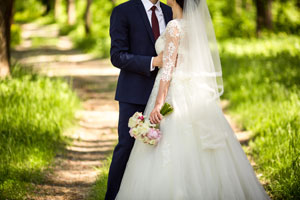· Couples forced to cut wedding spend as average cost increases to £8,000
· Wedding dress first to be cut when trying to save money, followed by guest list
· Canapés, favours and cars most likely to be ditched completely to reduce bill
· Couples raid current accounts to pay for wedding, as parents no longer cover the cost
· For tips to save money on wedding costs, visit www.nationwide.co.uk/wedding-costs
New research reveals couples are being forced to scale back their wedding plans as the average cost of getting married reaches £8,000.
The Nationwide Wedding Survey1, which polled 2,000 married UK adults, shows that spending on wedding dresses is first to be slashed in a bid to drive down the bill, while the number of guests, invitations and venue are also top items to be reduced when money gets tight.
Nationwide’s research shows the average amount spent on tying the knot has increased by over £400 since 20152, from around £7,500 to £7,959. Although nearly a quarter (24%) spend more than £10,000 and around one in ten (11%) spend more than £20,000.
And with many parents no longer contributing to the wedding, some couples find themselves raiding their current account and in debt up to two years after the event.
The poll shows respondents aged 25 to 34 still spend the most on average (£15,089), an increase of £3,885 since 2015, with the amount spent steadily declining as people get married later in life – with those aged 55 and over spending nearly four times less (£4,081) than their younger counterparts (25-34).

Parents of the bride
Contrary to tradition, over half (52%) of those polled said they had no financial help from their parents towards the cost of their wedding. Nearly a third (31%) said their parents contributed some money towards the wedding. Those living in the South East are more likely to have their wedding paid for by their parents (23%), compared to just 12 percent in the North East.
Wedding debt
With some couples not having enough savings to fund their wedding, many borrow money. The survey revealed more than a fifth (21%) raided their current accounts to pay for their special day, while one in ten (10%) used their credit card and one in 20 (5%) relied on a personal loan. However, more than a third (35%) of respondents didn’t set a wedding budget and nearly a quarter (24%) were left with wedding debt afterwards, which took an average of two years to pay off.
Cutting costs
For some, scaling down the wedding may be the only option, with the survey showing that over a quarter (29%) curbed their wedding plans to save money, with more women than men feeling they had to compromise (35% vs 23%). When it came to downgrading items, the wedding dress topped the list of items to be cut, with nearly half (48%) of couples saying they reduce this spend. Perhaps in a bid to cut costs, around one in five women (19%) opted for a high street shop wedding dress or borrowed or bought a second-hand wedding dress to save money.
The poll showed that respondents were more likely to cut out canapés and suit hire altogether, rather than downgrade them. The most and least popular options for reducing the overall cost of a wedding are:
Most likely to be reduced (% of people):
· Wedding dress: 48%
· Number of guests: 47%
· Invitations: 44%
· Venue: 44%
· Food: 42%
Least likely to be reduced (% of people):
· Canapés: 14%
· Suit hire: 16%
· Cutting plus one: 18%
· Banning children: 21%
· Favours: 22%
Most likely to be cut out altogether (% of people):
· Canapés: 55%
· Favours: 43%
· Car: 35%
· Suit hire: 34%
· Paid bar: 33%
Least likely to be cut out altogether (% of people):
· Rings: 8%
· Food: 10%
· Venue: 13%
· Flowers:16%
· Number of guests:16%
Top ways to save money include roping in family members to take photos or videos (16%), using their own car rather than hiring one (16%), making wedding invitations rather than buying them (15%) and asking for money instead of a wedding gift (13%).
Regional variations
There is a significant regional difference in the amount people spend on weddings and civil partnerships, with London being the only area where the average spend is as high as £13,067. This is more than £7,500 higher than the area of lowest spend – East Midlands – where the average wedding spend is £5,518. The UK regional averages are as follows:
Average wedding spend by region:
· London: £13,067
· West Midlands: £8,796
· Northern Ireland: £8,327
· North West £8,159
· Wales: £8,051
· South West: £7,052
· North East: £6,957
· East Anglia: £6,452
· Yorkshire and the Humber: £6,249
· Scotland: £5,960
· South East: £5,852
· East Midlands: £5,518
Phil Smith, Nationwide’s Head of Current Accounts, said: “Weddings and civil ceremonies represent one of the biggest occasions in someone’s life and will probably be one of the most expensive too. It can often take years of saving to make the big day a reality, which is perhaps why many of us cut down on key parts of the wedding to save costs, including the dress, guest numbers, invitations and suit hire. As our research shows, a quarter of us dip into our current accounts to cover the costs of getting married. We would always recommend people look to put money aside, whether that be in an ISA or regular savings account, particularly for those big life events. That way you won’t unknowingly be left out of pocket.”


Add new comment